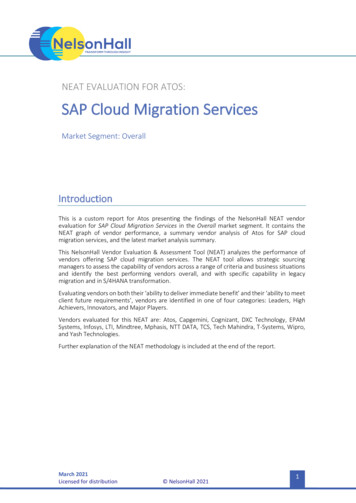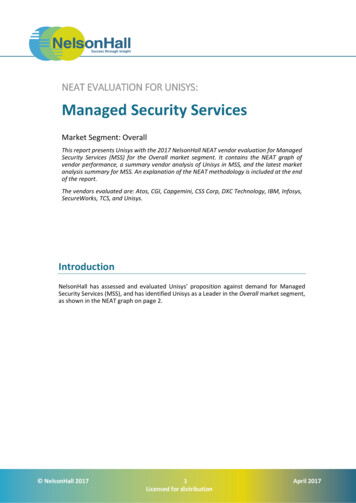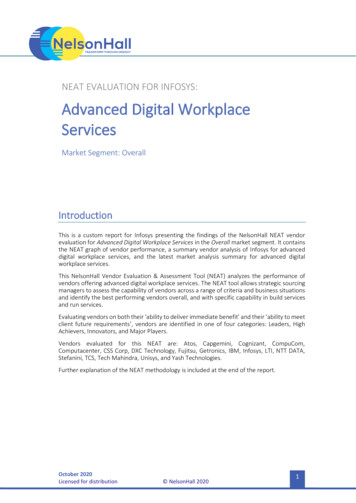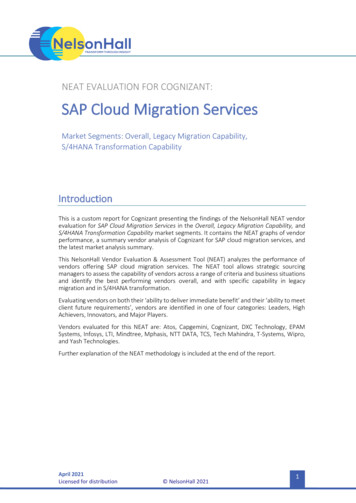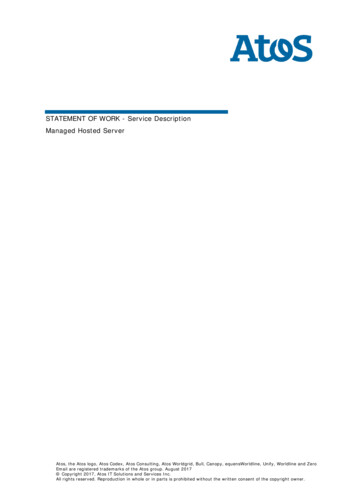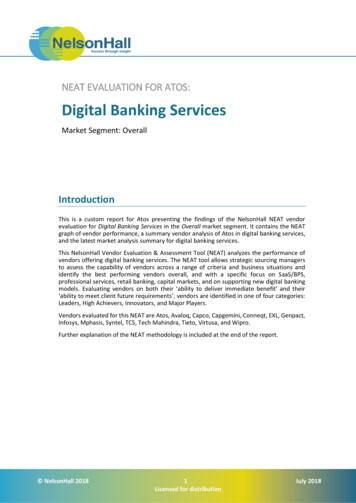
Transcription
NEAT EVALUATION FOR ATOS:Digital Banking ServicesMarket Segment: OverallIntroductionThis is a custom report for Atos presenting the findings of the NelsonHall NEAT vendorevaluation for Digital Banking Services in the Overall market segment. It contains the NEATgraph of vendor performance, a summary vendor analysis of Atos in digital banking services,and the latest market analysis summary for digital banking services.This NelsonHall Vendor Evaluation & Assessment Tool (NEAT) analyzes the performance ofvendors offering digital banking services. The NEAT tool allows strategic sourcing managersto assess the capability of vendors across a range of criteria and business situations andidentify the best performing vendors overall, and with a specific focus on SaaS/BPS,professional services, retail banking, capital markets, and on supporting new digital bankingmodels. Evaluating vendors on both their ‘ability to deliver immediate benefit’ and their‘ability to meet client future requirements’, vendors are identified in one of four categories:Leaders, High Achievers, Innovators, and Major Players.Vendors evaluated for this NEAT are Atos, Avaloq, Capco, Capgemini, Conneqt, EXL, Genpact,Infosys, Mphasis, Syntel, TCS, Tech Mahindra, Tieto, Virtusa, and Wipro.Further explanation of the NEAT methodology is included at the end of the report. NelsonHall 20181Licensed for distributionJuly 2018
NEAT Evaluation for Atos: Digital Banking ServicesNEAT Evaluation: Digital Banking Services (Overall)NelsonHall has identified Atos as a Leader in the Overall market segment, as shown in theNEAT graph. This market segment reflects Atos’ overall ability to meet future clientrequirements as well as delivering immediate benefits to digital banking services clients.Leaders are vendors that exhibit both a high ability relative to their peers to deliverimmediate benefit and a high capability relative to their peers to meet client futurerequirements.Buy-side organizations can access the Digital Banking Services NEAT tool (Overall) here. NelsonHall 20182Licensed for distributionJuly 2018
NEAT Evaluation for Atos: Digital Banking ServicesVendor Analysis Summary for AtosOverviewAtos has delivered services to the banking industry since its inception in 1997. Atos beganwith the merger of Axime (the primary shareholder was Bank Paribas) and Sligos; itselfformed in 1970 through the merger of Cegos Informatique and Sliga, Crédit Lyonnais’ dataprocessing subsidiary.Over time Atos has grown its retail banking services delivery capabilities through multipleacquisitions, including: Odyssée: January 2000, financial services consultancy Worldline: 2004 Atos creates a division (Worldline) from its continental Europeanpayment processing capabilities. It acquires Indian payments processor, VentureInfotech, in 2010. In 2014, it did an IPO of Worldline shares, retaining 75% ownership Canopy (2012): Atos entered into a joint venture with EMC and VMware to create a cloudhosting and services entity named Canopy. In 2015 Atos acquired all of Canopy and todayall its cloud and hosting services are delivered out of Canopy Bull (2014): Atos completed the acquisition of Bull, expanding the Atos' private managedcloud, cyber-security, big data, and data center capabilities Xerox ITO (2015): Atos completed the acquisition of Xerox ITO, expanding its NorthAmerican cloud operations with Xerox’s virtual machine and storage business, whichoperated out of North America data centers Equens & Paysquare (2016): completion of the acquisitions of the payments processorsEquens and Paysquare Engage ESM (2017): Atos acquired Engage ESM, a ServiceNow Gold Services partner,enabling Atos to offer enterprise and emerging customers an enhanced portfolio ofcloud based service-management solutions InTouch (2017): Worldline and Total signed a technology, commercial, and financingagreement with African fintech InTouch. Worldline and Total will support thedeployment acceleration of the “Guichet Unique” platform in eight African countries(Senegal, Ivory Coast, Cameroon, Burkina Faso, Guinea (Conakry), Mali, Morocco, andKenya) DRWP (2017): Worldline acquired Digital River World Payments, an online globalpayment service provider MRL Posnet (2017): Worldline acquired MRL Posnet to obtain a terminal managementplatform, enabling cost efficient deployment and management of new terminals. MRLPosNet processes payment transactions on behalf of 18 Indian banks, through themanagement of 100k payment terminals Diamis (2017): reinforcement of Worldline’s Account Payments division through theacquisition of Diamis.In 2013, Atos began its digital banking services capabilities by establishing a partnership withBackbase, a vendor of customer experience software that delivers: portal, mobile, content,targeting, and forms in a single platform. The partnership was a reseller partnership, but itallowed Atos to start delivering a large amount of digital banking implementation services to NelsonHall 20183Licensed for distributionJuly 2018
NEAT Evaluation for Atos: Digital Banking Servicesclients, especially banks. The initial implementation was for a Middle Eastern bank, one ofthe largest Islamic banks in the world.Atos accelerated its digital services initiatives by merging its consulting, applicationmanagement and system integration units into a single service line, Consulting & SystemIntegration (C&SI) in 2014.In Q4 2016, Atos established a three-year strategy to focus on digital transformation acrossall industries, including BFS, a major focus for Atos.Atos’ digital banking services have 6.7k FTEs. Employees by service line include: Consulting: 5% Design and develop: 70% BPS: 25%It delivers services for digital banking from many centers including India, Poland, and multipleonshore locations. Atos anticipates growing digital banking services staffing levels in existingcenters in response to client demand.Atos has 150 digital banking services, clients, out of 250 banking clients, including 12 of thelargest 20 banks in the world. Atos’ clients for digital banking services are institutionsheadquartered in: Europe: 70% North America: 20% APAC: 10%Clients include: Retail banks: 75% Capital markets firms: 20% FinTech firms: 5%Clients targeted by tier include: Tier one institutions: 70% primary focus Tier two and other: 30% secondary focus, the primary focus of Worldline.FinancialsAtos’ digital banking services revenues were an estimated 335m in calendar year 2017. NelsonHall 20184Licensed for distributionJuly 2018
NEAT Evaluation for Atos: Digital Banking ServicesStrengths Large portfolio of proprietary IP with key technologies: loan origination andmanagement, data management, payments, fraud detection, cybersecurity, and clouddelivery Strong data center footprint in Europe Close relationships with many leading digital product vendors Aggressive acquisition approach has demonstrated commitment and enables Atos togrow its digital services capabilities.Challenges Lack of mid-tier bank clients and startup client engagements Needs to raise the profile of North American and APAC businesses.Strategic DirectionAtos targets tier one and global banks in all geographies for its digital banking services. It usesdigital services as a key differentiator to attract new business. Atos has developed a set ofkey digital services it is promoting to clients including: Industry-specific services: Worldline payments: Currently new offerings include instant payments, PSD2, andopen bankingCybersecurity: key offerings address transaction security and fraud mitigationBlockchain: including smart contracts and paymentsLoan utilityBranch management and CX Digital workplace: collaboration to create and implement digital platforms, including CXand omnichannel delivery Codex: analytics and data management Canopy: cloud and platform reinvention and management.Atos works with a large group of digital product vendors and industry groups to develop andcommercialize solutions for its banking clients. It has also grown its capabilities via acquisitionto access technology and clients to grow its digital services business. It intends to continue togrow its digital banking services inorganically as opportunities occur.It is now beginning to productize its digital offerings to speed the adoption of services for tierone clients. Productization of offerings has occurred first in payments with its Worldlineofferings. Its next large growth area for productization will be in lending. NelsonHall 20185Licensed for distributionJuly 2018
NEAT Evaluation for Atos: Digital Banking ServicesDigital Banking Services Market SummaryBuy-Side DynamicsThe digital banking services market is established with global banks, while lower tier banksare just beginning to undertake widespread adoption. Drivers include: Revenue generation to offset margin declines, pulling in customers by accommodatingtheir preferences Cost: need to achieve operations cost reduction ( 40%-80% savings) at all volumeswithout re-platforming Variabilize costs to allow successful entry into previously subscale markets (product orgeographic markets) Compliance: required changes in open banking, transaction execution (payments andtrades), and data management (privacy).The primary client profile is: Current: Tier 1 banks remain the primary adopters (80% revenue) and fintechs/regionals(20% revenue) Future: expand into regional banks, exchanges, specialist firms, and services vendors(i.e., custodians and payments vendors) Future, global banks: support cloud delivery, industry shared services, and open banking.Clients are buying service bundles including: Consulting (12% overall), design and deployment (70%), and operations support (18%) Internal bank operations deployment (80%) and external delivery (20%) (of which BPS is60% and cloud 40%) Design and deployment: key are valid use cases and commit to step in and maintain thesolution if the ISV fails Emerging: consulting (10.5%, decreased share), design and deployment (70.5%), andoperations support (19.0%, increased share) Emerging: internal bank operations deployment (40%, decrease) and external delivery(60%, increase). BPS (20%, decrease) and cloud and XaaS (80%, increase) Emerging: enable open banking and real-time payments by establishing business processconsortia.Consulting is well understood and increasingly uses a fixed price model. Two years ago, fixedprice was 20% of contracts. D&D contracts are priced entirely on a per FTE model, wheretechnology is emerging and complex. D&D, where technology is well understood (oftenproprietary), is moving to fixed price. Projects often billed by milestone achievement.Subscription pricing is evolving into a preference for transaction pricing to mitigate the clientrisk of volume swings. Non-transaction based services, such as cybersecurity remains monthlyfee focused. NelsonHall 20186Licensed for distributionJuly 2018
NEAT Evaluation for Atos: Digital Banking ServicesThere are other significant drivers for decisions to seek third party support from vendors. Thetop drivers for banks are: Poor revenue growth has impeded banks’ ability to develop scale economies. Banks needto increase their customer base to amortize costs over larger revenues. They also needto harvest greater value from their legacy customer base. Low margins and revenuesindicate that aggressive cost reduction is required to remain solvent. New customers areprimarily non-banked consumers (i.e., young, less wealthy). Delivery costs must be muchlower for new customers to be profitable. New offering development: high cost of entry and variation across low volume marketsdrives the need for low cost execution. New market penetration: Compliance necessitates high standardization of executionacross and within market.Market Size & GrowthDigital banking services is a growing market with high adoption by tier 1 banks in maturemarkets, and low adoption by mid/small tier banks. Current adoption is from global banks,with single product tower engagements. Vendors are delivering elemental processes focusedon trialing technology.NelsonHall estimates the size of the digital banking service market to be 7,215m in 2017,and that it will grow at 10.0% per year in the period 2017 to 2022.The digital banking services market starts with consulting services, which accounts for 12%( 890m) of client spend and is growing at 7.0% over the forecast period. Design anddeployment accounts for 70% ( 5,085m) of client spend and is growing at 10.0% over theforecast period. Operations support is moving rapidly from an emerging to establishedmarket status, with 18% of client spend ( 1,240 m). Operations support will grow 12.0% peryear over the same period.Success FactorsKey success factors for clients include:Digital ecosystem development: Vendor ecosystem: identify services vendors with knowledge of client’s operationsenvironment and business issues. Select vendors for each capability withcomplementary skills. Minimizing the number of vendors within each capability set is keyto reducing bottlenecks Key vendor attributes: employees with industry expertise and digital technologyexperience. Vendors should have compliance expertise, centers of excellence, relevantAPI libraries, consulting and development capabilities.Execution: Redefine external/internal operations split: ability to create required proprietaryoperations from standardized components (both SaaS operations and BPaaS operations) Share overhead: internal operations using standardization and SSCs, external operationswith cloud delivery NelsonHall 20187Licensed for distributionJuly 2018
NEAT Evaluation for Atos: Digital Banking Services Time to market: standing up digital initiatives faster than direct competitors and Fintechstartups.Vendor selection: Scale and breadth of delivery, both labor and cloud, across many geographies Breadth of partnerships, functionality, roadmap, implementation framework andfinancial strength Vendors need to participate in industry councils (both business and technology) andproduct client advisory boards Preferred vendors should have widest pool of IT services providers supporting them.ChallengesThe key challenges faced in digital banking services include:External challenges: Global banks are sole adopters of customized single solutions. Today regional banks andglobal banks are moving to productized, cloud delivered solutions covering multiplegeographies and product silos Regulations: compliance has been the primary challenge for the past five years. Nowregulations will drive business model change (i.e., open banking, instant payments, etc.) Immature technology and fragmented vendor landscape: vendors must be monitoringthe changing vendor landscape and provide BCDR services where vendors fail. Newemerging technologies (e.g., blockchain, AI) will continue to require these services tomitigate technology challenges Political concerns on labor impacts of robotics and privacy concerns of AI, data, and web Access to data from 3rd parties when internal transactional data is limited Cybersecurity: as delivery moves to omnichannel, security becomes increasingly hard todeliver and public failures increase management concerns Blockchain, AI, and cognitive remain very early stage technologies, far behindomnichannel and RPA in adoption. Key AI functionality to date is focused on customerattitude interpretation via the manipulation of unstructured data. Key blockchain to dateis focused on low volume trading cases, but almost no operational deployments.Internal challenges:Operational: Talent acquisition and retention: digital domain qualifications are in short supply, andhighly specialized. Market leadership and learning opportunities at a vendor are key toattracting and retaining talent. Cost of training is high and can only be recovered overmany implementations Expand the functionality which digital addresses: cost efficiency is very high ( 60% costreduction), but currently applicable to few processes and functionalities, limiting theoverall impact on business ( 10% of cost base). Vendors need to address the entireoperations value chain of each process to deliver a significant impact to operations NelsonHall 20188Licensed for distributionJuly 2018
NEAT Evaluation for Atos: Digital Banking Services Clients demand customization: engagements have been custom projects with limitedopportunity to reuse IP, even within a single global client. Acceleration requires muchhigher reuse of IP across engagements Migration risk: Clients expect the vendor to retain the migration risk of new deploymentsvia pricing schemes Process selection: Articulating, curating, and reusing high yield use cases is critical toprofitable engagement. Industry knowledge to identify the operations ecosystem of aprocess is key to maximizing value for engagements.Automation of processes: Cloud/PaaS/systems integration/consolidation: Banks of all sizes increasingly havelimited internal staff, requiring support for IT. Vendors looking to grow with this marketmust be able to deliver automation as-a-service Monitoring ISVs, and related industries: Digital banking is experiencing a period ofproduct proliferation. Vendors need to understand both the vendor landscape andindustry challenges Design thinking: successful implementation of digital requires a redesign of processes.Understanding how humans use the technology is critical to improving usability andsatisfaction with processes.OutlookVendors are introducing digital banking services offerings with process automation acrosschannels and data management embedded into the processing services including:Emerging technology: Standardizing offerings and implementation services and rolling out to broaderaudiences for mature digital technologies (i.e., CUX, mobile, automation) Developing cybersecurity, AI, and cloud delivery offerings (CUX offerings more mature,but growing)Staff training: Developing frameworks to standardize approach to evolving technology and APIs/toolsto automate tasks Partnering with schools and ISVs to train and onboard staff in hard to fill skillsets Monitor the fast-evolving digital solution vendor landscape and provide guidance toclientsSolutions: Modularizing proprietary IP and creating API libraries for emerging third-party IP. Development of sales/marketing initiatives, with focus on omni-channel and socialmedia Cybersecurity replaces compliance as primary focus of risk mitigation. NelsonHall 20189Licensed for distributionJuly 2018
NEAT Evaluation for Atos: Digital Banking ServicesNEAT Methodology for Digital Banking ServicesNelsonHall’s (vendor) Evaluation & Assessment Tool (NEAT) is a method by which strategicsourcing managers can evaluate outsourcing vendors and is part of NelsonHall's Speed-toSource initiative. The NEAT tool sits at the front-end of the vendor screening process andconsists of a two-axis model: assessing vendors against their ‘ability to deliver immediatebenefit’ to buy-side organizations and their ‘ability to meet client future requirements’. Thelatter axis is a pragmatic assessment of the vendor's ability to take clients on an innovationjourney over the lifetime of their next contract.The ‘ability to deliver immediate benefit’ assessment is based on the criteria shown in Exhibit1, typically reflecting the current maturity of the vendor’s offerings, delivery capability,benefits achievement on behalf of clients, and customer presence.The ‘ability to meet client future requirements’ assessment is based on the criteria shown inExhibit 2, and provides a measure of the extent to which the supplier is well-positioned tosupport the customer journey over the life of a contract. This includes criteria such as thelevel of partnership established with clients, the mechanisms in place to drive innovation, thelevel of investment in the service, and the financial stability of the vendor.The vendors covered in NelsonHall NEAT projects are typically the leaders in their fields.However, within this context, the categorization of vendors within NelsonHall NEAT projectsis as follows: Leaders: vendors that exhibit both a high ability relative to their peers to deliverimmediate benefit and a high capability relative to their peers to meet client futurerequirements High Achievers: vendors that exhibit a high ability relative to their peers to deliverimmediate benefit but have scope to enhance their ability to meet client futurerequirements Innovators: vendors that exhibit a high capability relative to their peers to meet clientfuture requirements but have scope to enhance their ability to deliver immediate benefit Major Players: other significant vendors for this service type.The scoring of the vendors is based on a combination of analyst assessment, principallyaround measurements of the ability to deliver immediate benefit; and feedback frominterviewing of vendor clients, principally in support of measurements of levels of partnershipand ability to meet future client requirements. NelsonHall 201810Licensed for distributionJuly 2018
NEAT Evaluation for Atos: Digital Banking ServicesExhibit 1‘Ability to deliver immediate benefit’: Assessment criteriaAssessment CategoryOfferingsDeliveryPresence NelsonHall 2018Assessment CriteriaDigital banking consultingProcess modelling in support of digital bankingDevelopment & implementation services for digital bankingAbility to drive new digital banking modelsBreadth of application of digital bankingDigital banking support for retail banking processesDigital banking support for core banking processesDigital banking support for capital markets processesAbility to digitalize KYCAbility to incorporate digital within BPSScale of digital delivery capabilityBlockchain delivery capabilityExtent of partnerships in support of digital bankingDegree of proprietary IP in support of digital bankingDigital payments delivery capabilityU.S. delivery capabilityU.K. delivery capabilityContinental Europe delivery capabilityRest of EMEA delivery capabilityAPAC delivery capabilityLATAM delivery capabilityUse of pre-existing digital banking templatesDigital banking change management capabilityMaturity of digital banking delivery modelDigital banking governance capabilityOverall digital banking presenceIn retail bankingIn capital marketsU.S. presenceU.K. presenceContinental European presenceRest of EMEA presenceAPAC presenceLATAM presence11Licensed for distributionContinued July 2018
NEAT Evaluation for Atos: Digital Banking ServicesContinued Level of cost savingsError reductionCycle time reductionImproved CSATImproved complianceIncreased revenuesImproved digitalization of banking processesIntroduction of new digital banking productsBenefits AchievedExhibit 2‘Ability to meet client future requirements’: Assessment criteriaAssessment CategoryAssessment CriteriaService InnovationPerceived suitability to meet future digital banking needsPerceived suitability to develop new digital banking models &processesAbility to apply automation to banking processesService cultureInnovation & creativityLevel of InvestmentsIn digital banking services overallIn support of retail bankingIn support of capital marketsIn own tools & platforms to support digital bankingIn news systems of engagement for the banking sectorIn blockchain-related servicesMarket MomentumDigital banking services market momentumFor more information on other NelsonHall NEAT evaluations, please contact the NelsonHallrelationship manager listed below.Sales EnquiriesNelsonHall will be pleased to discuss how we can bring benefit to your organization. You can contactus via the following relationship manager:research.nelson-hall.comGuy Saunders at guy.saunders@nelson-hall.comImportant NoticeCopyright 2018 by NelsonHall. All rights reserved. NelsonHall exercises its best efforts in preparation of the information provided in this reportand believes the information contained herein to be accurate. However, NelsonHall shall have no liability for any loss or expense that may resultfrom incompleteness or inaccuracy of the information provided. NelsonHall 201812Licensed for distributionJuly 2018
vendors offering digital banking services. The NEAT tool allows strategic sourcing managers . Atos entered into a joint venture with EMC and VMware to create a cloud hosting and services entity named Canopy. In 2015 Atos acquired all of Canopy and today all its cloud and hosting services are delivered out of Canopy Bull (2014): Atos .
